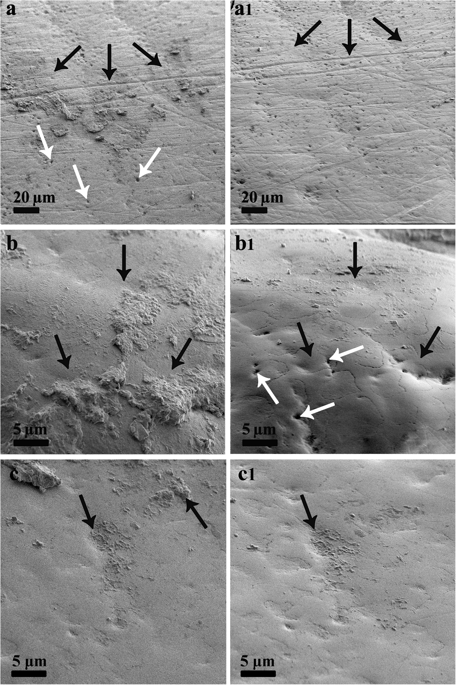BDJ Open ( IF 2.5 ) Pub Date : 2018-09-27 , DOI: 10.1038/s41405-018-0005-5 Siân B Jones 1 , Nicola X West 1 , Pavel P Nesmiyanov 2, 3 , Sergey E Krylov 4, 5 , Vera V Klechkovskaya 5 , Natalya A Arkharova 5 , Svetlana A Zakirova 6

|
Objectives/Aims
To evaluate the antimicrobial activity of a newly developed foam mouthwash containing a modified lactoperoxidase system in vitro.
Materials and methods
Biofilms of five bacterial species were developed on hydrophobic and hydrophilic surfaces whilst salivary-based biofilm was grown on tooth enamel. Each surface was exposed to the foam mouthwash or saline in vitro. Optical density and scanning electron microscopy (SEM) was used to determine retention of the biofilm following 5 or 30 s exposure time.
Results
The foam mouthwash was active against biofilms formed by S. aureus, K. rhizophila, M. thailandicus, E. coli, and C. violaceum and eliminated significant amount of biofilm from each surface; immature 4 h biofilm was less resistant than 24 h biofilm. A 30 s rinse showed best performance, with removal of up to 66% of biofilm from the hydrophilic surface. SEM imaging confirmed oral biofilm removal from the enamel surface after a 5 s rinse with the foam mouthwash.
Discussion
Foam mouthwash demonstrated a significant impact on growing biofilm when compared against saline solution. Growing biofilms were more susceptible to the action of the foam mouthwash, which justifies after-meal use of the mouthwash when traditional dentifrices may not be accessible.
Conclusions
Foam mouthwash can be a convenient on-the-go format of oral care products that can be used after meals or when needed to reduce the risk of biofilm-associated oral conditions.
中文翻译:

泡沫漱口水的抗菌功效及其去除生物膜的能力
目的/目标
体外评估新开发的含有改良乳过氧化物酶系统的泡沫漱口水的抗菌活性。
材料和方法
五种细菌的生物膜在疏水性和亲水性表面上形成,而基于唾液的生物膜则在牙釉质上生长。每个表面都在体外暴露于泡沫漱口水或盐水。使用光密度和扫描电子显微镜 (SEM) 来确定 5 或 30 秒暴露时间后生物膜的保留情况。
结果
泡沫漱口水对金黄色葡萄球菌、根际克雷伯菌、泰国分枝杆菌、大肠杆菌和紫罗兰色念珠菌形成的生物膜具有活性,并消除了每个表面的大量生物膜;未成熟的 4 小时生物膜的抵抗力低于 24 小时生物膜。 30 秒的冲洗显示出最佳性能,可从亲水表面去除高达 66% 的生物膜。 SEM 成像证实,用泡沫漱口水冲洗 5 秒后,牙釉质表面的口腔生物膜被去除。
讨论
与盐水溶液相比,泡沫漱口水对生物膜的生长具有显着影响。不断生长的生物膜更容易受到泡沫漱口水的作用,这证明在无法获得传统牙膏的情况下,饭后使用漱口水是合理的。
结论
泡沫漱口水是一种方便携带的口腔护理产品,可在饭后或需要时使用,以降低与生物膜相关的口腔疾病的风险。











































 京公网安备 11010802027423号
京公网安备 11010802027423号